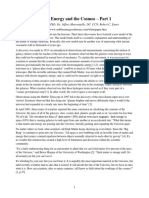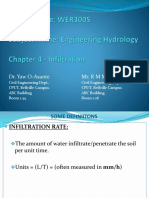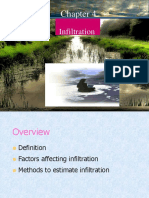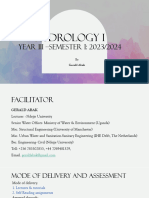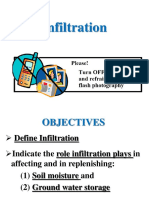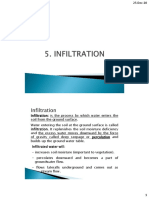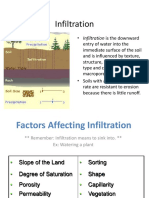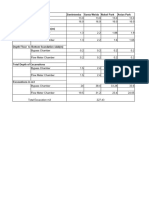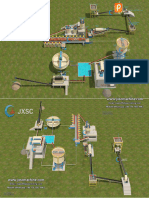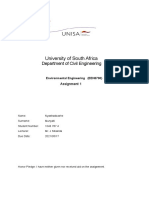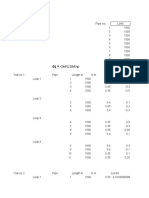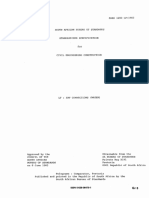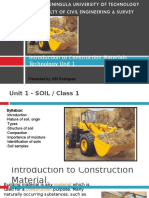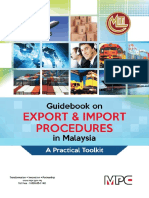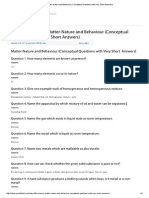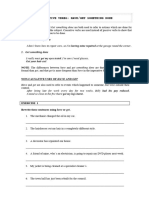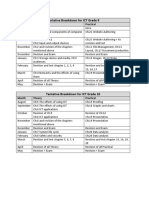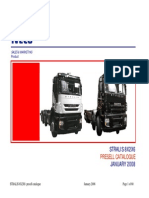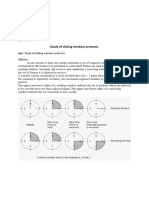Subject Code: WER300S Subject Name: Engineering Hydrology Chapter 4 - Infiltration
Uploaded by
nyashadzashe munyatiSubject Code: WER300S Subject Name: Engineering Hydrology Chapter 4 - Infiltration
Uploaded by
nyashadzashe munyatiSubject Code: WER300S
Subject Name: Engineering Hydrology
Chapter 4 - Infiltration
Dr. Yaw O-Asante Mr. R M Mambwe
Civil Engineering Dept., Civil Engineering Dept.,
CPUT, Bellville Campus. CPUT, Bellville Campus.
ABC Building ABC Building
Room 1.34 Room 1.06
SOME DEFINIITONS
INFILTRATION RATE:
The amount of water infiltrate/penetrate the soil
per unit time.
Units = (L/T) = (often measured in mm/h)
2
SOME DEFINIITONS
INFILTRATION CAPACITY (fc):
Maximum rate soil can absorb water. (but fc varies
with soil wetness, rain intensity, etc.)
Units = (L/T) = (often measured in mm/h)
3
NFILTRATION PROCESS
Infiltration rate varies with time according to the
current moisture level within the soil zone and the
current rainfall intensity.
As the moisture level increases the infiltration rate
will decrease. However, at a certain moisture level, the
rate will reach a minimum value, known as the infiltration
capacity (fc).
Therefore in measuring infiltration, the focus is normally on
measuring either the maximum rate (the initial infiltration
rate (f0)) or the minimum rate (fc).
4
NFILTRATION PROCESS
At start of a rainfall event on dry ground (with soil fc > i), water
will infiltrate into the soil at a rate equal to the rainfall intensity
(i).
Infiltration rate will remain equal to the rainfall intensity until
the soil zone becomes saturated.
Now the actual infiltration(f) rate becomes equal to the
infiltration capacity rate (fc) [ excess rain is runoff]
Shape of infiltration vs time curve after this point will be
influenced by the initial soil moisture content and the rainfall
intensity:
5
METHODS TO MEASURE INFILTRATION - INFILTROMETERS
1. Flooding Infiltrometers
They are usually rings or tubes inserted in the ground.
Water is applied and maintained at a constant level and
observations made of the rate of replenishment required.
The rings are cantered by
the welded handle on the
top of the unit; this
insures the rings stay in
place while driving them
into the soil.
6
METHODS TO MEASURE INFILTRATION - INFILTROMETERS
1. Rainfall simulators
Here, artificial rainfall is simulated over a small test plot
and the infiltration calculated from observations of
rainfall and runoff, with consideration given to
depression storage and interception.
This is a special
device, combination
of the ponded ring
infiltration and
simulated rainfall
methods.
It easily and rapidly
takes measurements.
7
METHODS TO CALCULATE INFILTRATION - MODELS
1. HORTON’S INFILTRATION MODEL
Assumption: if rainfall intensity (i) is greater than the
infiltration rate/capacity (f), f would decrease exponentially
with time. Eventually the rate would reach a minimum as time
tends to infinity:
8
METHODS TO CALCULATE INFILTRATION - MODELS
1. HORTON’S INFILTRATION MODEL
kt
f t f c ( f o f c )e
where:
ft = the infiltration rate (depth/time) at some time t (mm/hr);
k = a constant dependent on soil type and representing the rate
of decrease in f capacity (1/hr);
fc = the final (minimum or equilibrium) infiltration capacity
(mm/hr);
f0 = the initial infiltration capacity (mm/hr).
9
HORTON’S INFILTRATION MODEL
1. Factors influencing fc, fo,
and k (Wilson, 2011)
k is a function of surface
texture: if vegetation is
present k is small and for a
bare surface k is large.
10
HORTON’S INFILTRATION MODEL
1. Factors influencing fc, fo,
and k (Wilson, 2011)
fo and fc are both functions
of soil type and vegetal
cover: e.g. A bare sandy or
gravelly soil will have high
values of fo and fc whereas a
bare clayey soil have low
values low values, but both
values will increase for
both soils if they are turfed.
11
HORTON’S INFILTRATION MODEL
1. Factors influencing fc, fo,
and k (Wilson, 2011)
fc is a function of :
Slope, up to a range of 16% to
24% (no variation beyond this
range)
Initial moisture content – the
dryer the soil initially, the larger
fc will be
Rainfall intensity – if the
intensity increases, fc increases.
Rain intensity has a greater
effect than all variables
12
HORTON’S INFILTRATION MODEL
1. representative values of fc, fo, and k (Wilson, 2011)
13
ɸ - INDEX METHOD
The ɸ-index (infiltration index )is used to obtain a
reasonable approximation of infiltration losses.
The method assumes the infiltration rate is constant.
The index is defined as the value of average rainfall
such that any exceedence of the value will result in
surface runoff.
In simple terms, φ index is a value above which we get
runoff and below which we get infiltration.
14
ɸ - INDEX METHOD
This means that if the value of rainfall is known for a
particular storm and also the total depth of surface
runoff is known (e.g. calculated from hydrograph), the
index can be determined graphically and also through
iteration. 15
ɸ - INDEX METHOD
The index combines interception, depression
storage and infiltration characteristics. That is:
if: Rainfall – (ɸ-index) = Runoff
and: Rainfall – Losses = Runoff
and also: Losses = interception + depression storage + ET +
infiltration
then: ɸ-index = interception + depression storage + ET +
infiltration
Although for storms of long duration, losses due to
interception, depression storage and ET tends to
minimum compared with the total amount of rain,
and φ index tends to average infiltration rate.
16
ɸ - INDEX METHOD (Han, 2010)
17
ɸ - INDEX METHOD (Han, 2010)
18
You might also like
- Subtle Energy and The Cosmos - Part 1 Yury KronnNo ratings yetSubtle Energy and The Cosmos - Part 1 Yury Kronn10 pages
- INFILTRATION - Presentation - 1 - Gerald - AbakNo ratings yetINFILTRATION - Presentation - 1 - Gerald - Abak63 pages
- 4-Infiltration - READY - FINAL - 2018-2020 - Modified - 2No ratings yet4-Infiltration - READY - FINAL - 2018-2020 - Modified - 247 pages
- 26901322018 CE(PC)502 Engineering HydrologyNo ratings yet26901322018 CE(PC)502 Engineering Hydrology33 pages
- 1aRainfall Abstraction With Examples on Green and AmptNo ratings yet1aRainfall Abstraction With Examples on Green and Ampt15 pages
- Infiltration: Indices and Measurement of Infiltration (With Diagram)No ratings yetInfiltration: Indices and Measurement of Infiltration (With Diagram)9 pages
- Learning Module: Surigao State College of Technology Module No. 3 Infiltration I. TopicNo ratings yetLearning Module: Surigao State College of Technology Module No. 3 Infiltration I. Topic9 pages
- Highton Warralily - Coloured Brochure - WebNo ratings yetHighton Warralily - Coloured Brochure - Web1 page
- Civil Designer Training Reservation Form - All Regions & InternationalNo ratings yetCivil Designer Training Reservation Form - All Regions & International6 pages
- Teachers Without Borders Programme: Brought To You byNo ratings yetTeachers Without Borders Programme: Brought To You by3 pages
- University of South Africa: Department of Civil EngineeringNo ratings yetUniversity of South Africa: Department of Civil Engineering2 pages
- Teachers Without Borders Programme: Brought To You byNo ratings yetTeachers Without Borders Programme: Brought To You by5 pages
- Introduction To Construction Materials Technology Unit 1: Presented By: KM RodriguezNo ratings yetIntroduction To Construction Materials Technology Unit 1: Presented By: KM Rodriguez16 pages
- Edwards Critical Care Quick Guide To Cardiopulmonary Care PDF100% (1)Edwards Critical Care Quick Guide To Cardiopulmonary Care PDF188 pages
- City Government of San Pablo, Laguna Vs Reyes Degest100% (1)City Government of San Pablo, Laguna Vs Reyes Degest2 pages
- Guidebook On Export and Import Procedures in Malaysia (A Toolkit)No ratings yetGuidebook On Export and Import Procedures in Malaysia (A Toolkit)279 pages
- Matter-Nature and Behaviour (Conceptual Questions With Very Short Answers)No ratings yetMatter-Nature and Behaviour (Conceptual Questions With Very Short Answers)4 pages
- Syllabus Bookkeeping-Career Diploma: Program Code: BK PrerequisitesNo ratings yetSyllabus Bookkeeping-Career Diploma: Program Code: BK Prerequisites5 pages
- Bar Chart How Students Spend Their Time Practice - AnswersNo ratings yetBar Chart How Students Spend Their Time Practice - Answers1 page
- 8_updated_tcs-smarthiring-sample-question-paper (2)No ratings yet8_updated_tcs-smarthiring-sample-question-paper (2)5 pages
- Smartbright Led Downlight 427761 Ffs AenNo ratings yetSmartbright Led Downlight 427761 Ffs Aen4 pages
- .TR 2023 Bahar Yökdi̇l Sosyal-Sinav KampiNo ratings yet.TR 2023 Bahar Yökdi̇l Sosyal-Sinav Kampi29 pages
- EN-12004 Impac On Adhesive Formulations PDF100% (2)EN-12004 Impac On Adhesive Formulations PDF28 pages
- Aim: Study of Sliding Window Protocol. TheoryNo ratings yetAim: Study of Sliding Window Protocol. Theory9 pages
- Ancient Greece Medicine PowerPoint PresentationNo ratings yetAncient Greece Medicine PowerPoint Presentation46 pages



